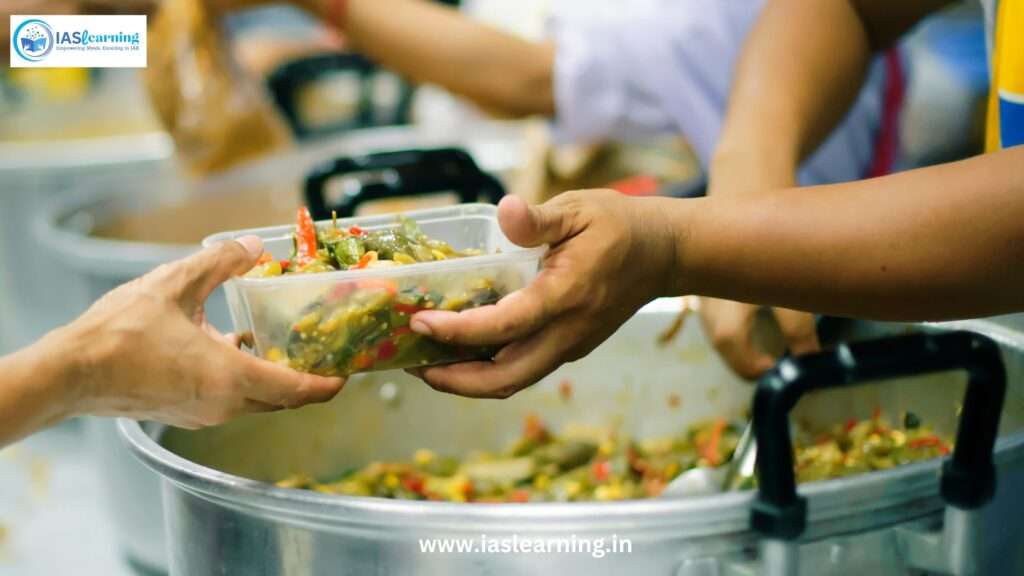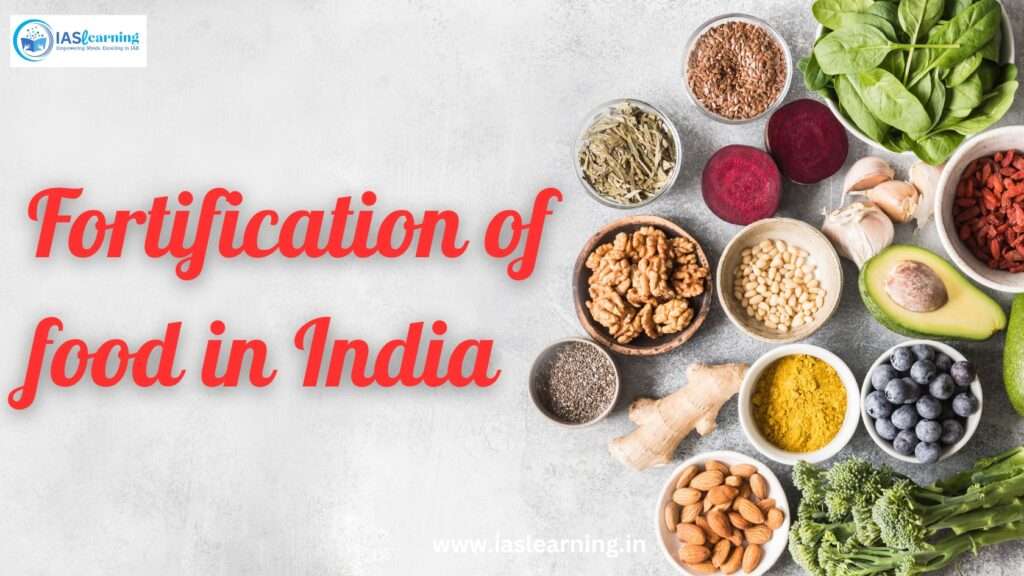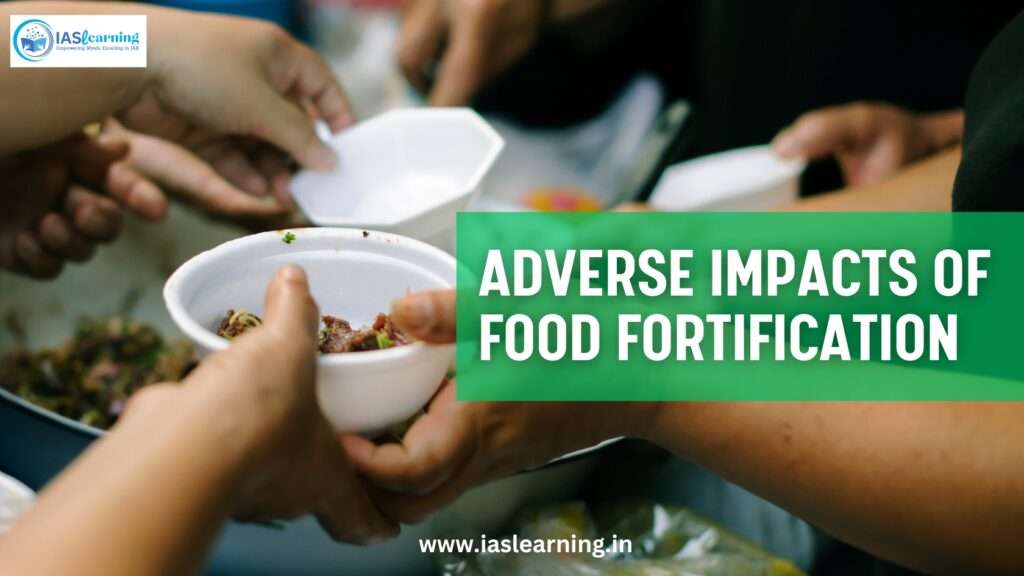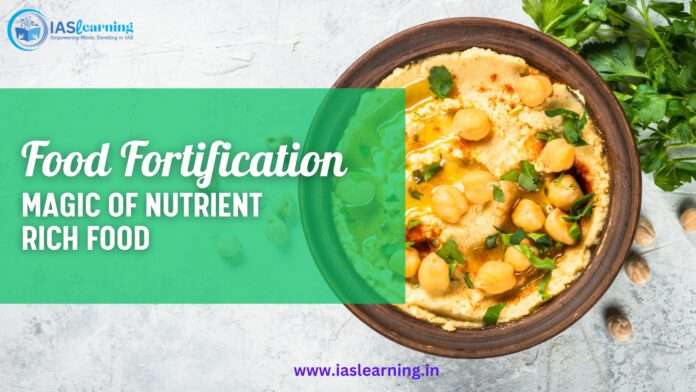FOOD FORTIFICATION
- A report “Do India’s Food Safety Regulator (FSSAI) and Indian Citizens Need Saving from (Foreign & Indian) Private Players Behind Food Fortification Initiatives?” was released.
- According to the World Health Organization (WHO), food fortification is defined as the practice of deliberately increasing the content of essential micronutrients so as to improve the nutritional quality of the food supply and to provide a public health benefit with minimal risk to health.
- To address anaemia and micro-nutrient deficiency in the country, Government of India approved the Centrally Sponsored Pilot Scheme on “Fortification of Rice & its Distribution under Public Distribution System” for a period of 3 years beginning 2019-20 with total budget outlay of Rs 174.64 Cr.
Types of Food Fortification
- Targeted: Food fortification can be done for foods widely consumed by the general population (mass fortification), to fortify foods designed for specific population subgroups, such as complementary foods for young children or rations for displaced populations.
- Market-Driven: Toallow food manufacturers to voluntarily fortify foods available in the marketplace (market-driven fortification).
Procedure of Food Fortification

- The extent to which a national or regional food supply is fortified varies considerably. The concentration of just one micronutrient might be increased in a single foodstuff (e.g., the iodization of salt), or, at the other end of the scale, there might be a whole range of food–micronutrient combinations.
- In October 2016, Food Safety and Standards Authority Of India (FSSAI)operationalized the Food Safety and Standards (Fortification of Foods) Regulations, 2016 for fortifying staples namely Wheat Flour and Rice (with Iron, Vitamin B12 and Folic Acid), Milk and Edible Oil (with Vitamins A and D) and Double Fortified Salt (with Iodine and Iron) to reduce the high burden of micronutrient malnutrition in India.
- India’sNational Nutritional strategy, 2017, had listed food fortification as one of the interventions to address anaemia, vitamin A and iodine deficiencies apart from supplementation and dietary diversification.
Recent developments in food fortification
- For a period of three years commencing in 2019–20, the Ministry of Consumer Affairs, Food, and Public Distribution initiated a centrally supported pilot program on “Fortification of Rice and its Distribution under Public Distribution System (PDS)” with a total budget outlay of Rs.174.64 crore.
- The pilot program is concentrated in 15 districts throughout 15 states.
- According to the plan, rice blending takes place throughout the milling process.
- Fortified rice is now being distributed in Gujarat and Maharashtra as part of a pilot program.
- The North-Eastern, hilly, and island states receive 90:10 of the Government of India’s funding for the Scheme, while the remaining states receive 75:25 of it.
Need of food fortification
- According to the National Family Health Survey (NFHS-4):
- 4% of children (6-59 months) are anaemic
- 1% women in the reproductive age group are anaemic
- 7% of children under 5 are underweight
- Also, it is estimated that 50-70% of these birth defects are preventable. One of the major causes is deficiency of Folic Acid.
- India has slipped to 101st position in the Global Hunger Index (GHI) 2021 of 116 countries, from its 2020 position of 94th.
- Thus, fortification is necessary to address deficiency of micronutrients or micronutrient malnutrition.
Fortification of food in India

Currently government is promoting fortification in following 5 food items:
- Rice: Department of Food and Public Distribution (DFPD) has been running a Centrally Sponsored Pilot Scheme on Fortification of Rice & its distribution through Public Distribution System”. The scheme was initiated in 2019-20 for a three-year pilot run.
- This scheme will run till 2023 and rice will be supplied to the beneficiaries at the rate of Re 1 per kilogram.
- Wheat: The decision on fortification of wheat was announced in 2018 and is being implemented in 12 states under India’s flagship Poshan Abhiyaan to improve nutrition among children, adolescents, pregnant mothers and lactating mothers.
- Edible oil: Fortification of edible oil, too, was made compulsory across the country by FSSAI in 2018.
- Milk: Fortification of milk was started in 2017 under which the National Dairy Development Board of India (NDDB) is pushing companies to add vitamin D.
Food Fortification Resource Centre (FFRC)
- It was set up in the year 2016 under the FSSAI. It provides a common platform for the various stakeholders like the representatives from the central ministers, the development partners, food manufacturers, food processors and people who produce the fortification premix for food fortification.
- Its primary functions include:
- Disbursement of food fortification-related information.
- Sensitize states regarding the benefits of food fortification.
- Technical support to the small food manufacturers.
- Training and capacity building for large-scale food fortification.
| Fortification of Rice & its Distribution under Public Distribution System |
| Distribution of Fortified Rice through Public Distribution System, to cater 15 Districts in the country – preferably one district per State in the initial phase of Implementation.Coverage of NFSA, beneficiaries under PDS with Fortified Rice in the selected Districts.Facilitate cross learning and sharing of best practices among States/UTs and Department of Food & Public Distribution.To evaluate the provision, coverage and Utilization of Fortified Rice by the target population as well as the efficiency/effectiveness of the consumption of fortified rice in reducing the targeted micronutrient deficiencies in different age and gender groups. |
Global stand on Food fortification

- The World Health Organization recommends large-scale food fortification as a powerful evidence-informed and cost-effective intervention to fight vitamin and mineral deficiencies, including iodine deficiency disorders, anemia, and iron deficiency, among others.
- Recommendations in all settings include:
- Universal salt iodization
- Fortification of maize flour, corn meal, wheat flour, and rice with vitamins and minerals.
- For children living in different settings:
- Micronutrient powders containing iron for point-of-use fortification of foods for infants and young children 6–23 months old or children 2–12 years.
- Mandatory food fortification occurs when governments legally oblige food producers to fortify particular foods or categories of foods with specified micronutrients, providing high certainty over time that they will contain a predetermined amount.
Advantages of Food Fortification
- Increase in Nutritional Value: The biofortified crops have 1.5 to 3 times higher levels of protein, vitamins, minerals and amino acids compared to the traditional varieties.
- Safer Method of Fortification: It is worth noting that these varieties are not genetically modified — they have been developed through conventional crop breeding techniques by scientists.
- Moreover, the addition of micronutrients to food does not pose a health risk to people. The quantity added is so small and so well regulated as per prescribed standards that the likelihood of an overdose of nutrients is unlikely.
- Nutritional Security at Large: Since the nutrients are added to staple foods that are widely consumed, this is an excellent method to improve the health of a large section of the population, all at once.
- Does Not Require Behaviour Change: It does not require any changes in food habits and patterns of people. It is a socio-culturally acceptable way to deliver nutrients to people.
- It does not alter the characteristics of the food: The taste, the feel, the look.
- Quick Results: It can be implemented quickly as well as show results in improvement of health in a relatively short period of time.
- Cost Effective: This method is cost-effective especially if advantage is taken of the existing technology and delivery platforms.
- The Copenhagen Consensus estimates that every 1 Rupee spent on fortification results in 9 Rupees in benefits to the economy.
- It requires an initial investment to purchase both the equipment and the vitamin and mineral premix, but overall costs of fortification are extremely low. Even when all program costs are passed on to consumers, the price increase is approximately 1-2%, less than normal price variation. Thus, it has a high benefit-to-cost ratio.
Adverse Impacts of Food Fortification

- Not a Substitute of Good Nutrition: While fortified foods contain increased amounts of selected micronutrients, they are not a substitute for a good quality diet that supplies adequate amounts of energy, protein, essential fats and other food constituents required for optimal health.
- Fails to Cater to the Poorest Segment of the Population: Poorest segments of the general population have restricted access to fortified foods in the open markets due to low purchasing power and an underdeveloped distribution channel.
- Inconclusive Evidence:
- Evidence supporting fortification is inconclusive and certainly not adequate before major national policies are rolled out.
- Many of the studies which FSSAI relies on to promote fortification are sponsored by food companies who would benefit from it, leading to conflicts of interest.
- Can Have Detrimental Effects: Adding one or two synthetic chemical vitamins and minerals will not solve the larger problem, and in undernourished populations can lead to many detrimental effects like toxicity.
- A study showed iron fortification causing gut inflammation and pathogenic gut microbiota profile in undernourished children.
- Decrease Value of Natural Food: Once iron-fortified rice is sold as the remedy to anaemia, the value and the choice of naturally iron-rich foods like millets, varieties of green leafy vegetables, flesh foods, liver, to name a few, will have been suppressed by a policy of silence.
Way Forward
- Increasing Women’s Nutritional Literacy: There is a direct correlation between mothers’ education and the wellbeing of children. Children with mothers who have no education have the least diversified diets and suffer from stunting and wasting and are anaemic.
- Hence, programmes for improving the educational status of girls and reducing the school dropout rates, particularly at the secondary and higher educational levels, need to be promoted.
- The Global Nutrition Report (2014) estimates that every dollar invested in a proven nutrition programme offers benefits worth 16 dollars.
- Increasing Expenditure on Agri-R&D: Innovations in biofortified food can alleviate malnutrition only when they are scaled up with supporting policies.
- This would require increasing expenditure on agri-R&D and incentivising farmers by linking their produce to lucrative markets through sustainable value chains and distribution channels.
- Private Investment: The government can also rope in the private sector to create a market segment for premium quality biofortified foods to cater to high-end consumers.
- For instance, trusts run by the TATA group are supporting different states to initiate fortification of milk with Vitamin A and D.
- Other private dairies should also be encouraged to scale up milk fortification across the country.
- National Level Programme: A national awareness drive on the lines of the“Salt Iodisation Programme” launched by the government in 1962 to replace ordinary salt with iodised salt, can play an important role at the individual and community levels to achieve the desired goals of poshan for all.
- Branding, awareness campaigns, social and behavioural change initiatives, such as community-level counselling, dialogue, media engagement and advocacy, especially amongst marginalized communities, can promote consumption of locally available, nutrient-dense affordable foods among the poor and children.
- Need For Multi-Pronged Approach: It must be recognised that in the long run, India needs a multi-pronged approach (access to basic infrastructure (electricity, drinking water and sanitation)) to eliminate the root cause of this complex problem.




